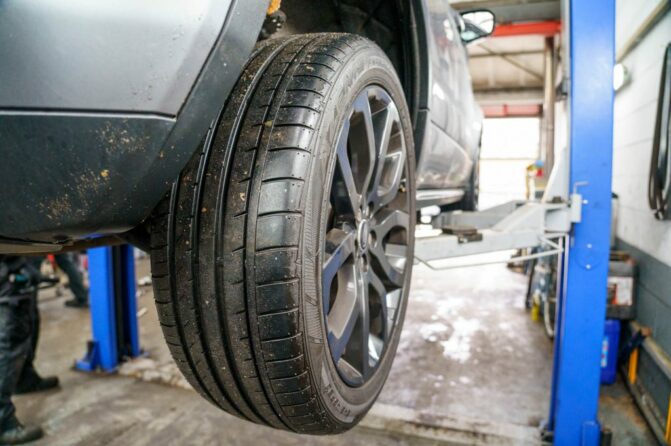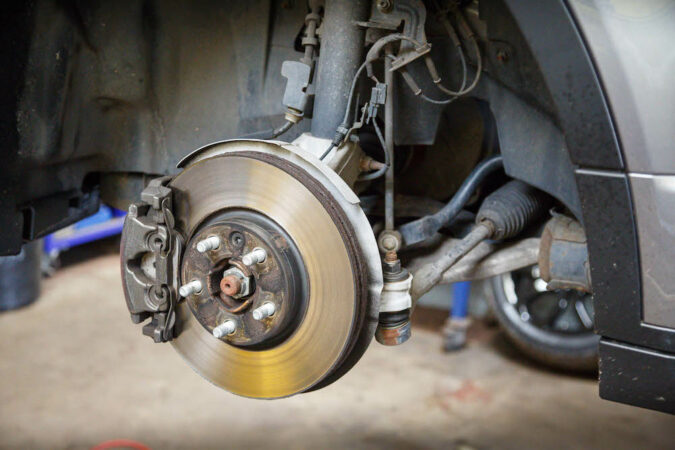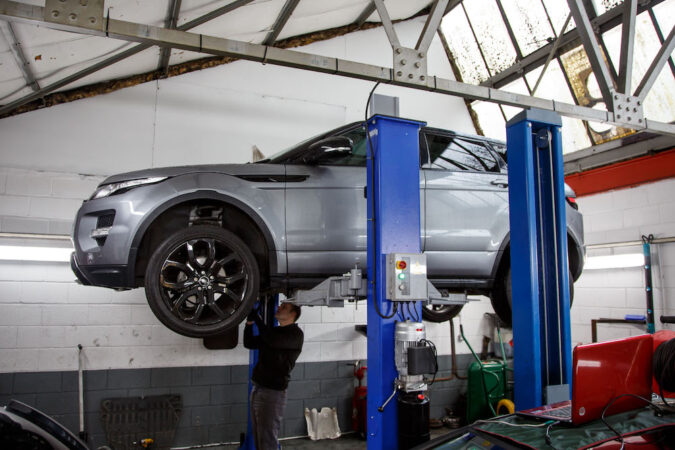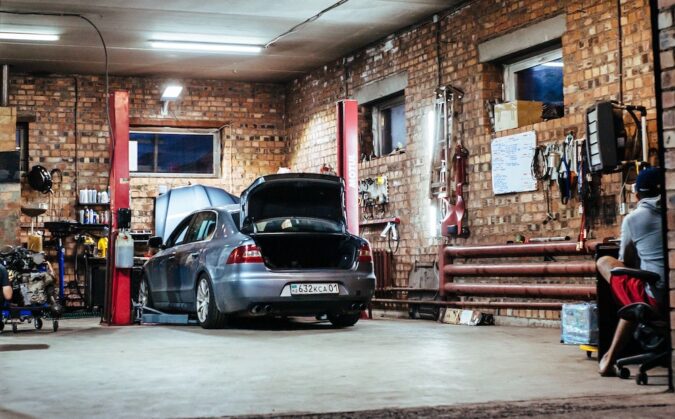Wheel alignments and new tires are essential to car ownership and maintenance. Your mechanic may also recommend an alignment after new tires, but is that really necessary? What even is an alignment for?
The quick answer to the question is that it isn’t always necessary, but it depends on several things. To understand more, and to help you decide whether or not you should do a wheel alignment after new tires, this post will discuss everything there is to know about wheel alignments. Here’s our table of contents to help you find the information you need:
What Is A Wheel Alignment
Just in case you’re not familiar, let us explain what a wheel alignment is first. If you already know what the process entails, then feel free to skip to the next section.
A wheel alignment, sometimes referred to as tire alignment, is the process of adjusting several angles of the car’s wheel to return it to the manufacturer’s specification. This reduces tire wear, optimizes handling, and ensures that the car travels straight and true while you’re driving.
The process entails putting the car on a rack. And then by using a specialized machine, the mechanic can know the current angles of the wheels and what to adjust. They will then adjust the wheels’ angles as necessary by adjusting the mounting position of the struts, steering knuckles, and other steering and suspension components.
The three major angles that are adjusted during the process are:
- Camber is the tilt angle of the wheels when viewed from the front. If the top of the tires tilts inward, then it has negative camber. On the other hand, positive camber is when the top of the tires tilts outward.
- Toe is the angle the wheels are facing when viewed from above. Toe out is when the front part of the tires is facing outwards, and toe-in is when it faces inwards (towards the car).
- Caster angle is the angle of the car’s suspension strut to the tire when viewed from the side. A positive caster is when the angle slopes rearward, while a negative caster is when it slopes to the front of the car.
The specifications vary depending on the car’s make and model. We recommend watching the video above to understand more about the wheel alignment process, and it’ll give you a better understanding of all the different wheel angles.
Why Is A Wheel Alignment Necessary?
A wheel alignment is necessary because the wheels’ angles naturally change over time due to vehicle load and weight transfer while driving. Additionally, driving through rough roads with loads of potholes and speed bumps is likely to alter the angles more quickly and dramatically due to the frequent impact on the suspension assembly.
Also, some suspension assemblies are more susceptible to angle changes due to their design, such as the MacPherson strut assembly. Meanwhile, the double wishbone suspension has a more rigid design, making it less susceptible. However, it will still require an alignment over time.
This wheel angle change is unavoidable regardless of your car’s make, model, and suspension type. All suspension assemblies will have changes in the camber, toe, and caster angle over time. And when it happens, it will affect the car’s handling and tire wear.
If you neglect this, you’ll experience uneven tire wear and it will negatively affect the car’s handling. The steering can become less responsive, or the car may not drive straight and true. In extreme cases, the car will become less stable when cornering.
Alignment After New Tires: Alignment Cost
The cost varies depending on your car’s make and model, as well as the local labor rates. But on average, it’ll cost between $100 to $150 to do an alignment on all four wheels. Expect luxury and performance cars to cost more, especially if you do it at the dealership.
Sometimes, alignments are only necessary on the front wheels. If this is the case, then a front-end alignment is usually between $60 – $100 on average.
The process usually takes no more than an hour. But it can take up to two hours if major adjustments are necessary. And no, you can’t do this at home as the process requires a wheel-alignment machine to identify the current angles. Without it, you’ll be eye-balling the angles and adjustments and won’t be able to do precise work.
Alignment Before Or After New Tires
It doesn’t really matter whether you do an alignment before or after new tires. Wheel alignment is adjusting the suspension and wheels, not the tires.
On a personal level, I prefer to do it after getting new tires. Why do an alignment if you’re going to come back to the shop a month later to change the tires? Might as well do it in one go, no? But is an alignment after new tires necessary? Well, that depends on when the last time you did a wheel alignment.
Wheel alignments are necessary every two years or between 6,000 miles to 10,000 miles depending on the car. If you just did an alignment recently, then an alignment after new tires is probably not necessary.
For example, let’s say your last alignment was 3,000 miles ago and you’re changing your tires now. This means the alignment was done relatively recently, and you probably don’t need to do an alignment right now. Of course, there’s no harm in doing it, but if you’re a bit tight on cash then it’s not necessary.
The general consensus is that it doesn’t matter whether you do an alignment before or after getting new tires. The important thing is to do the alignment when it’s time, and pay attention to when your car may need a wheel alignment.
How About A Tire Balancing?
A tire balancing is an entirely different process from a wheel alignment. And unlike the latter, tire balancing is always necessary when you get new tires. Unbalanced tires will have uneven mass distribution, and this results in uneven tire wear and the steering wheel shaking at high speeds.
The tire balancing process requires the mechanic to put the wheels on a tire balancing machine. This machine lets the mechanic know the current mass distribution on the tire. If your tires are unbalanced, then the mechanic will add, remove, and/or relocate the weights on the wheels as necessary to ensure mass distribution. These metal weights usually attach to the inner side of the wheel’s lips.
Afterward, your mechanic will use the machine to spin the tires again to see if it’s balanced now. Once the tires are balanced, then the mechanic will install the wheels back on the car. This process typically costs between $30 to $100 for all four wheels. But most tire shops usually already include it in the price of the new tires.
A tire balancing should be done around every 5,000 miles or six months. The most common sign you need it is when the steering wheel shakes when you’re driving above 50mph. Unbalanced tires can cause uneven and excess wear, and can wear out suspension components in the long run.
Car Shakes After New Tires And Alignment
There are two possible causes if your car is shaking after new tires and an alignment. The more likely scenario is that your mechanic didn’t perform a tire balancing (or didn’t do it properly) when installing the new tires.
However, note that unbalanced tires usually cause only the steering wheel to shake, and not the entire car. Additionally, it usually happens above 50mph, although severely unbalanced tires can cause the steering wheel to shake at speeds as low as 30mph.
If it happens at a slower speed and it’s the entire car that’s shaking, then it’s possible the wheel alignment isn’t done properly. In any case, it’s best to head back to the shop immediately and ask them to inspect the problem. A tire balancing is usually the solution to this.
Car Alignment Symptoms
Note that the wheel alignment interval is just a general guideline on when you should do a wheel alignment. Some cars may need an alignment sooner than later, and here are the signs that your car needs a wheel alignment:
1. Uneven Tire Wear
Uneven tire wear can happen in several ways. It could be that your left tire wears faster than your right tire. Or that certain areas of the tires are wearing down faster than the other. It all depends on how the wheel angles have changed.
In my experience, the most common one is the inner side of the tires wearing down more than the outside. This is due to excessive negative camber, which is when the top of the tires tilt inward excessively. This causes the inner part of the tire to be in constant contact with the road, and the outer side is rarely in contact.
In this scenario, you’re effectively only using the inner side of the tire when you drive. As a result, the inner side wears down faster and you’ll have uneven wear on the tires. We recommend watching the video above to learn the different ways uneven tire wear can happen.
2. Off-Center Steering Wheel
An off-center steering wheel is when it isn’t centered when the car is traveling in a straight line. In other words, the steering wheel has to be at a bit of an angle for the car to travel in a straight line. An easy way to tell is to drive on a straight stretch of road, and see if the logo on the steering wheel is up straight.
If it isn’t, then the steering wheel is off-center. Or some people may call it a “crooked steering wheel.” Whatever you want to call it, this is a sign that you need a wheel alignment. Note that this is different from the car pulling to one side. Speaking of which:
3. The Car Is Pulling To One Side
A bad wheel alignment can also cause the car to pull to one side when driving. If your car has a good wheel alignment, then the car should travel straight and true when you let go of the steering wheel. If you notice the steering wheel pulling to one side, then you have misaligned wheels.
This is usually because one or both of your front wheels has an excessive toe angle. This means it’s tilting and facing to one side and resulting in the car pulling. However, note that there are other potential causes. Here’s a video on how to diagnose it:
If the car pulls to one side only when braking, then this means one of your brakes isn’t engaging. For example, if the car pulls to the left while braking, this means only the left-side brakes are working and the right-side brakes aren’t engaging.
This is usually due to issues at the brake lines, where the hydraulic fluid isn’t reaching the calipers properly and it can’t engage the rotor/brake disc to slow down the wheel’s rotation. But there are other possible causes. We recommend reading our guide here to further diagnose it.
Bad Wheel Alignment Causes
As mentioned, the general interval for a wheel alignment is around every two years or between 6,000 to 10,000 miles. And there are symptoms that you should keep a lookout for as well. But if you notice that your car needs a wheel alignment frequently, there are several potential causes:
- Worn wheel bearings. (it might be time to find wheel bearing repair shops near me)
- Bad tie-rod or tie-rod ends.
- Bad shocks and struts.
- Worn CV joints.
Other bad suspension components can cause this problem as well, but the four things above are the most common causes. Once those components wear out, it can affect the rigidity of the suspension assembly. As a result, the smallest impact can affect the wheel’s angle, leading to a frequent need for wheel alignment.
Note that it’s possible that the components are fine, and instead, you’re just not driving carefully. Yes, you may be at fault here. Driving over potholes, hitting curbs, and minor collisions can change your wheel’s angle.
All of those things above cause an impact on your suspension components and can alter the wheel’s angles. If you’re not careful and drive over potholes at high speeds, this can greatly alter the angle. This also means that if you often drive on rough roads, you’re likely to require a wheel alignment more frequently.
So, drive carefully. Try not to hit any curbs and avoid collisions as best as you can. And if you’re driving through rough roads with lots of potholes and speed bumps, slow down and avoid the potholes if possible. Not only does this prevent changes in wheel angles, but it helps your suspension components to last longer.
Facts on Wheel Alignments: Why they’re Important and When to Get One
- Regular wheel alignments involve adjusting the angles of a vehicle’s steering and suspension components to the manufacturer’s original specifications.
- Misaligned tires and wheel assemblies can lead to reduced fuel efficiency, accelerated tire wear, and poor drivability.
- Les Schwab provides different alignment services, including 4-wheel and thrust alignments, based on the vehicle’s type and size.
- Common causes of wheel misalignment include potholes, dirt roads, hitting curbs or speed bumps, normal wear and tear, and impacts from fender-benders or road debris.
- Symptoms of misalignment include pulling to one side, an off-center steering wheel, the need for constant steering corrections, and uneven tire wear.
- New tires, lifting or lowering a vehicle, adjusting or replacing suspension parts, and having a fender-bender are some of the instances that may require a wheel alignment check.
- Camber affects tire wear, and positive camber increases stability at higher speeds, while negative camber may cause handling issues.
- Caster affects steering and handling, and a higher caster increases stability, while a lower caster provides more responsive handling.
- Toe is the most important angle for tire life, and proper calibration to manufacturer specifications is necessary to reduce friction on tires.
- Before getting a wheel alignment, it is advisable to replace damaged suspension parts first and ask for a printout of the before and after alignment measurements for record-keeping.
FAQ About Alignment After New Tires
We get a lot of questions about wheel alignment and tires. We try to answer as many questions as possible below:
What Is Wheel Alignment
A wheel alignment is a process of adjusting the angles of your car’s wheels back to the manufacturer’s specification. The angles that are adjusted are the camber, toe, and caster angle. The process entails putting the car on a wheel alignment machine to identify the current angles. Then the mechanic will adjust it as necessary, by adjusting the mounting angles of the struts, steering knuckle, suspension links, and other steering and suspension components. This ensures the car travels straight and keeps tire wear to a minimum.
How Long After New Tires Should I Get An Alignment
Your tire change doesn’t determine when you need to get an alignment. Instead, a wheel alignment is usually done every 2 years or between 6,000 to 10,000 miles depending on your car’s make and model. You can find the recommended interval in your service manual, or look out for signs that you need an alignment. This includes uneven tire wear, an off-center steering wheel, and the car pulling to one side when driving.
Do You Need Alignment After New Tires
You don’t unless your car is due for one. Check your service manual for the recommended interval, and look out for symptoms of a bad wheel alignment. Note that you need tire balancing when you get new tires to ensure even load distribution between tires. Otherwise, the car will shake at high speeds. Tire balancing is usually included in the price of the tire.
How Much Does An Alignment Cost
An alignment costs between $100 to $150 on average. However, luxury and performance cars are likely to cost more. And dealers will typically charge more than tire shops.
How Long Does An Alignment Take
An alignment usually takes no more than an hour for all four wheels. But it can take up to two hours if major adjustments are necessary.
How Much Is A Front End Alignment
If you’re doing an alignment only for the front wheels, then it typically costs between $60 to $100. Again, performance and luxury cars are likely to cost more.
Where To Get An Alignment
Almost all branches of national tire shop chains will have the equipment necessary to perform a wheel alignment. This includes Pep Boys, Jiffy Lube, and Firestone Complete Auto Care amongst others. Some dealerships and independent tire shops may also be capable of performing a wheel alignment. Best to call and make sure that they can do a tire alignment before you head over there.
How Often Should You Get An Alignment
Manufacturers typically recommend a wheel alignment every two years or between 6,000 to 10,000 miles. Check your service manual to find the recommendation, and keep a lookout for signs of a bad wheel alignment. If your car seems to need it frequently, then you likely have a worn-out suspension component that you need to replace.
How Long Does It Take To Get New Tires
It typically takes a skilled mechanic no more than an hour to install four new tires on a car. This also includes performing tire balancing, which is necessary every time you get new tires. If you’re not replacing all fours, then expect them to take around 10 minutes to replace each tire.
When Do You Need New Tires
A tire’s lifespan is anywhere between 30,000 to 60,000 miles. This depends on the type of tires you’re using, road conditions, your driving habits, and wheel alignment. Most tires have a wear indicator bar at the bottom of the tread grooves that sits laterally to the tire. If the bars are flush with the adjacent ribs, then it’s time to replace it. You can also check with a tire-tread gauge which costs around $10. Insert the gauge in the tread grooves, and it will take a reading. As long as it reads above 2/32 inches or 1.6 millimeters, then it’s still safe to use.
Alignment After New Tires: In Conclusion…
To summarize, a wheel alignment isn’t always necessary after getting new tires. Instead, it should be done every two years or 6,000 to 10,000 miles, regardless of whether your tires are old or new.
That being said, if your last alignment was 5,000 miles ago, and you’re getting new tires now, then there’s no harm in doing it now. So, you don’t have to go back to the shop any time soon and save yourself some time and effort.
There are also signs of misaligned wheels that you should look out for. This includes a crooked steering wheel, uneven tire wear, and the car pulling to one side when driving. If you notice this happens frequently, you likely have a worn-out suspension component.
Worn-out components such as ball bearings and tie-rods will cause the wheel alignment to change more dramatically and frequently. As a result, you’ll need a wheel alignment more often. If this is the case, you’ll need to replace the components to rectify the problem.
Last but not least, tire balancing is always necessary when getting new tires. This ensures the tires have even mass distribution, which avoids driving issues and premature wear on suspension components.
Most tire shops usually already include the tire balancing cost in the price of the new tire. If not, it should cost no more than $100 to balance all four tires. And note that you also need to do a tire balancing around every 5,000 to 6,000 months or six months. Hopefully, this has been helpful for you.




